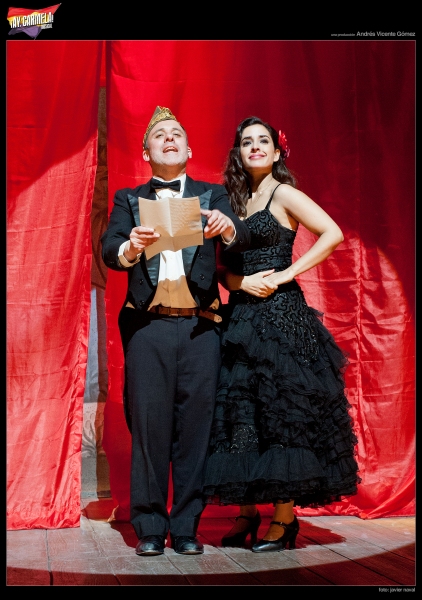
For many fans of Ay, Carmela! and
its author, Sanchis Sinisterra, the text, an actor and an actress
suffices. Using that as a starting point, much can be done; even
this brilliant musical version of the play with cabaret airs and an
invented narrator, Marta Ribera - a sort of minor Liza Minnelli,
though a magnificent performer with a wonderful voice. Marta
Ribera, in harmony with "Cabaret" and "Chicago," infuses the first
part of the show with that aroma. This super-production by Andrés
Vicente Gómez redeems him from the fateful pan-Arabism of "The Last
Horseman."
There is grandeur and a dazzling
sensory and political perspective in this show, assisted by García
Sánchez's version of the play and the scenography of Beatriz San
Juan. The screening of documentary images of the bombardments while
the Posodoble "Suspiros de España" (Sighs of Spain) plays provides
ample stimulus and conviction. Here we find similarities with the
work of theater theorist and director Vsevolod Meyerhold who, as an
artist and friend of painters, searched in the theater for harmony
and, as a politician, a proletariat biomechanical set-up.
The female narrator announces that
she is going to tell the story of a woman who is different from all
others; that marks the development of the first part of the show.
The powerful voice and presence of Marta Ribera overshadows the
simplicity that characterizes Carmela (Inma Cuesta) and Paulino
(Javier Gutiérrez). On the other hand, the narrative-dramatic
rhythm of the show reveals a Europe in flames, divided between
fascism and communism; the armed bourgeoisie and the armed
proletariat. It could be said that the first part is an epic play
while the second part is more intimate and tragic and more in line
with Sanchis's text. The epic element is recovered during the last
sequence of confrontation between the Phalangists and those who
have been sentenced to death, led by a member of the international
brigade who is in love with Carmela.
That kind of mercy shown by Carmela
- Michelangelo dramatized - as she comforts the wounded member of
the international brigade is memorable and noteworthy. In the face
of her compassion, Paulino's fear excels and expresses itself in
its most pathetic form; he is a poor soul and actor Javier
Gutiérrez (in that role) resorts to everything at his disposal:
fear, the scatological humor, alternating anguish of declaring
himself to be a communist at times and a fascist at others to save
his life; he is brilliant in the parody of Millán Astray (the
Spanish officer who founded the Spanish Legion), which justifies
the presence of Celia Gámez, the protégée of the legion's general,
in "Las Corsarias" (Spanish army marching tune) and in
thechotis(traditional dance of Madrid) "No pasarán" (the leftist
slogan: They Will not Pass).
The heroine is Carmela, the
beautiful woman who preserves her virtue in the face of advances
made by a passionate Italian and her Republican ideology from all
the others. Superb and in a state of grace, is Javier Navares in
his role as Ripamonte. As to Inma Cuesta, her performance is better
in the popular songs than in the rhythms composed by Victor Manuel,
Guerra and Vanesa Martín.
There are peak moments of good
theater, emotional intensity and political confrontation. For
example, in the sequence between the internationalist communists
and Italian fascists, the hymn of the international brigades and
the Jovineza del fascio (the Italian fascist hymn) reach a
crescendo that creates a clear, increasingly violent and
esthetically irreproachable atmosphere. Having noted the brilliant
role played by an afflicted and comical Javier Gutiérrez one must
highlight the superb direction of Lima and an overall performance
that is not only credible but thrilling.
JAVIER VILLÁN